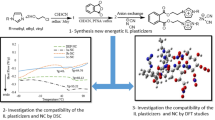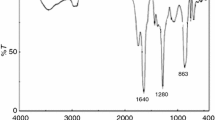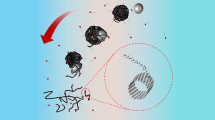Abstract
The compatibility of poly(3-nitromethyl-3-methyloxetane) (PNIMMO) with some energetic materials are studied by using pressure DSC method in detail. Cyclotetramethylenetetranitroamine (HMX), cyclotrimethylenetrinitramine (RDX), nitrocellulose (NC), nitroglycerine (NG), N-nitrodihydroxyethylaminedinitrate (DINA), and aluminum powder (Al) are used as common energetic materials, and 3,4-dinitrofurzanfuroxan (DNTF), 1,3,3-trinitroazetidine (TNAZ), hexanitrohexazaisowurtzitane (CL-20), 4,6-dinitro-5,7-diaminobenzenfuroxan (CL-14), 1,1-diamino-2,2-dinitroethylene (DADNE), and 4-amino-5-nitro-1,2,3-triazole (ANTZ) are used as new energetic materials. The results show that the binary systems of PNIMMO with HMX, RDX, NC, NG, DINA, Al, CL-14 and DADNE are compatible, with TNAZ, CL-20 and ANTZ are slightly sensitive, and with DNTF is sensitive.
Similar content being viewed by others
Explore related subjects
Find the latest articles, discoveries, and news in related topics.Avoid common mistakes on your manuscript.
Introduction
Poly(3-nitratomethyl-3-methyloxetane) (PNIMMO) is an energetic pre-polymer consisting of a nitrated ester group and an ether linkage (as shown in Scheme 1) [1], and can be used as an energetic binder in low vulnerability gun propellants, high impulse rocket propellants, elastomer modified double-base propellants, and high energy polymer-bonded explosives [2–7].
There are some reports on thermal behaviors of PNIMMO [7–11], and it has been found that PNIMMO decomposed readily to form gases under thermal conditions and was aging, both leading to voids in propellant or explosive compositions. If these compositions are then violently stimulated, the voids may collapse adiabatically forming hot spots which could lead to ignition. Degradation of PNIMMO can lead to an increase in its cross-linking density, resulting in being hard and brittle for a binder. This brittle binder would be vulnerable to shock waves which could result in an unwanted detonation. Degradation of PNIMMO can also lead to a decrease in its cross-linking density. Here plastic flow may arise resulting in changes to the surface area and burning characteristics.
Therefore, compatibility of PNIMMO with energetic materials in propellants or explosives is most important aspects of PNIMMO in practical application. However, investigations on these two aspects are rarely reported. Therefore, this study is to investigate the interactions and compatibilities between PNIMMO with some common and new energetic materials under the non-isothermal condition by means of pressure DSC technique [11–17].
Experimental
Materials
PNIMMO was prepared by Xi’an Modern Chemistry Research Institute, which purity was more than 99.4%, \( \overline{{M_{\text{n}} }} = 3400{-}3500,\;f_{\text{a}} = 1.753\). Cyclotetramethylenetetranitroamine (HMX), cyclotrimethylenetrinitramine (RDX), nitrocellulose (NC, 12.0% N), nitroglycerine (NG), N-nitrodihydroxyethylaminedinitrate (DINA) and aluminum powder (Al, d 50 = 10.48 μm) as common energetic materials were all industrially produced; 3,4-dinitrofurzanfuroxan (DNTF), 1,3,3-trinitroazetidine (TNAZ), hexanitrohexazaisowurtzitane (CL-20), 4,6-dinitro-5,7-diamino benzenfuroxan (CL-14), 1,1-diamino-2,2-dinitroethylene (DADNE), and 4-amino-5-nitro-1,2,3-triazole (ANTZ) as new energetic materials were synthesized by Xi’an Modern Chemistry Research Institute with all analytically pure. The structures of all the energetic materials are shown in Scheme 2.
The energetic material with weight of 2.0 g was dissolved in 10 mL solution of acetone and ethyl acetate with volume ratio of 2:1, respectively; and PNIMMO of 4.0 g dissolved in 20 mL the same solution. The solutions with PNIMMO and energetic material were mixed equably with volume ratio of 1:1, solvent volatilized by inches, and the mixtures PNIMMO and energetic materials with 50% PNIMMO were obtained.
Experimental equipments and conditions
All measurements were made with a model Netzsch DSC 204 HP differential scanning calorimeter (Germany).
The conditions for DSC measurements were as follows: sample mass, about 2.0 mg; heating rate, 10.0 °C min−1; atmosphere, static nitrogen, 1.0 MPa. The PNIMMO, energetic material or their mixture with weight of 2.0 mg was sealed in a sealed aluminum cell.
Results and discussion
Compatibilities of PNIMMO with some common energetic materials
Typical DSC curves of the binary systems 1–6 are shown in Fig. 1. Their maximum exothermic peak temperatures are shown in Table 1, and the evaluated standards of compatibility for explosive and contacted materials [16, 17] are listed in Table 2.
From Fig. 1, Tables 1 and 2, the following observations can be made.
-
The DSC curve of PNIMMO shows the main decomposition process in the temperature range of 186–238 °C with only one exothermic peak temperature of 218.2 °C, where the solid intermediate product
 and the gas products of CO, NO, HNCO, N2O, NO2, and HNO2 are formed [9].
and the gas products of CO, NO, HNCO, N2O, NO2, and HNO2 are formed [9]. -
The DSC curve of HMX consists of two endothermic peaks and one exothermic peak. The first peak at 200.3 °C is due to the crystal transformation from α to δ, and the second endothermic peak at 280.3 °C is due to the phase change from solid to liquid. The exothermic peak at 281.9 °C is caused by the rapid decomposition reaction. Affected by the decomposition process of PNIMMO, the crystal transformation peak of HMX moves to 193.8 °C during the heating course of binary system of PNIMMO–HMX, and the phase change vanishes. During the decomposition of the PNIMMO–HMX system, part of PNIMMO decomposes at 218.1 °C, part of HMX at 282.6 °C, and the dissolved mixture of PNIMMO and HMX decomposes at 237.3 °C.
-
Both of the endothermic peaks of RDX and PNIMMO–RDX DSC curves are caused by the phase change of RDX from solid to liquid. Similarly, the endothermic peaks of DINA and PNIMMO–DINA are also caused by the phase change of DINA from solid to liquid.
-
At the beginning of the decomposition of the PNIMMO–RDX system, both exothermic decomposition and endothermic phase-changes take place simultaneously in the temperature range of 200–206 °C, and then, the dissolved mixture of PNIMMO and RDX decomposes rapidly with peak temperature of 228.5 °C.
-
Because of the competition between the exothermic decomposition rates of both NG and the dissolved mixture of PNIMMO/NG, and of both DINA and the dissolved mixture of PNIMMO/DINA, a small cuspate peak presents itself before the presence of the strong exothermic peak in PNIMMO–NG or PNIMMO–DINA system.
-
Decomposition processes of NG and DINA are delayed by addition of PNIMMO, and the decomposition process of PNIMMO postponed by mixing of RDX, and the decomposition process of PNIMMO is, however, little affected by blending of Al. Thus, the maximum exothermic peak temperature difference (ΔT p) between NG, DINA or PNIMMO and PNIMMO–NG, PNIMMO–DINA, PNIMMO–RDX, or PNIMMO–Al are −2.9, −2.3, −10.3, and −0.3 °C, respectively. According to the standards of compatibility evaluated in Table 2, it is concluded that the binary systems PNIMMO–NG, PNIMMO–DINA, PNIMMO–RDX, and PNIMMO–Al have good compatibility.
-
The DSC curve of binary system PNIMMO–NC shows that there is a receivable effect on the decomposition process of PNIMMO and NC by mixing and dissolving of PNIMMO and NC. The values of ΔT p are 1.4 °C between NC and PNIMMO–NC, 0.1 °C between PNIMMO and PNIMMO–HMX, which indicate good compatibility between PNIMMO with NC and HMX, too.
-
The compatibility of the binary systems of PNIMMO/common energetic material decrease in the order 2 > 4 > 5 > 6 > 1 > 3.
-
The relative thermal stability of the binary systems of PNIMMO/common energetic material decrease in the order 2 > 6 ≈ 1 > 5 > 3 > 4.
Compatibility of PNIMMO with some new energetic materials
Typical DSC curves of systems 7–12 are shown in Fig. 2, their maximum exothermic peak temperatures are shown in Table 3.
From Fig. 2, Tables 2 and 3, the following observations can be made.
-
The endothermic peaks of DNTF, PNIMMO–DNTF, TNAZ, and PNIMMO–TNAZ DSC curves are caused by the phase change of DNTF and TNAZ from solid to liquid, while the endothermic peaks of DADNE and PNIMMO–DADNE are caused by the solid–solid phase transition of δ-DADNE to γ-DADNE.
-
The DSC curve of PNIMMO–DNTF shows that there is an obvious interaction between PNIMMO and DNTF. The mixture of PNIMMO and DNTF (liquid) decomposes slowly with the onset temperature (T o) of 147.8 °C and a wide exothermic peak reattaches itself in the DSC curve of the PNIMMO–DNTF system, while values of T o of neat PNIMMO and DNTF are 186.2 and 251.3 °C, respectively.
-
Similar to the binary systems PNIMMO–NG and PNIMMO–DINA, there is an exothermic shoulder peak before the main exothermic peak of the PNIMMO–TNAZ system, which is caused by the overlapping of the exothermic decomposition of TNAZ and the dissolved mixture of PNIMMO/TNAZ.
-
Similar to the decomposition process of system PNIMMO–HMX, there are three exothermic peaks in the DSC curve of PNIMMO–CL-14 system, which corresponds to the decomposition of part of PNIMMO at 220.2 °C, of part of CL-14 at 307.9 °C and of the dissolved mixture of PNIMMO and CL-14 at 263.2 °C.
-
From the DSC curves of PNIMMO, DADNE, and PNIMMO–DADNE system, it can be seen that there is little effect on the decomposition process of PNIMMO by DADNE, while the decomposition of DADNE is obviously accelerated by the addition of PNIMMO, with first exothermic peak moving from 239.0 to 232.8 °C and the second one from 294.0 to 266.1 °C.
-
The DSC curve of binary system of PNIMMO–CL-20 shows that most of CL-20 decomposes rapidly, together with PNIMMO decomposition in the temperature range of 187–226 °C with peak temperature of 215.2 °C, and the remainder CL-20 decomposes till 257 °C. Similarly, most of ANTZ decomposes rapidly together with PNIMMO, with temperature peak at 213.4 °C, and the remainder ANTZ decomposes at 267.7 °C.
-
According to the standards of compatibility evaluated in Table 2, it is considered that the binary systems PNIMMO–CL-14 and PNIMMO–DADNE have good compatibility with ΔT p of −2.0 and −0.3 °C, respectively.
-
The values of ΔT p between PNIMMO and PNIMMO–CL-20, PNIMMO–TNAZ and PNIMMO–ANTZ are 3.0, 3.1, and 4.8 °C, respectively. These phenomenons indicate that the decomposition reaction of the mixtures is easily to take place and the mixtures have fair compatibility.
-
The value of ΔT p between PNIMMO and PNIMMO–DNTF is 12.7 °C, showing that the increase of the rate of the decomposition reaction or reactivity and the poor compatibility of the mixture.
-
Both of the compatibility and the relative thermal stability of the binary systems of PNIMMO/new energetic material decrease in the order 10 > 11 > 9 > 8 > 12 > 7.
Conclusions
The reactivity or compatibility of the PNIMMO-energetic material mixture under the liner temperature increase condition at a heating rate of 10.0 °C min−1 at 1.0 MPa had been investigated by means of pressure differential scanning calorimetry. According to the evaluated standard of compatibility, it can be concluded that the PNIMMO–HMX, PNIMMO–RDX, PNIMMO–NC, PNIMMO–NG, PNIMMO–DINA, PNIMMO–Al, PNIMMO–CL-14, and PNIMMO–DADNE binary mixtures have good compatibility, however, the PNIMMO–TNAZ, PNIMMO–CL-20, and PNIMMO–ANTZ binary mixtures have fair compatibility and the PNIMMO–DNTF binary system has poor compatibility.
References
Bunyan PF. An investigation of the thermal decomposition of poly(3-nitrato-3-methyloxetane). Thermochim Acta. 1992;207:147.
Bunyan PF, Cunliffe A, Honey P. Plasticisers for new energetic binders. In: Proceedings of the 29th International Annual Conference of ICT, Fraunhofer Institut für Chemische Technologie, Karlsruhe; 1998.
Leach C, Debenham D. Advances in polyNIMMO composite gun propellants. Propellants Explos Pyrotech. 1998;23:313.
Wingborg N, Eldsater C. 2,2-Dinitro-1,3-bis-nitrooxy-propane (NPN): a new energetic plasticizer. Propellants Explos Pyrotech. 2002;27:314.
Xing XL, Xue L, Zhao FQ, Yi JH, Gao HX. Dissolution properties of hexanitrohexaazaisowurtzitane (CL-20) in ethyl acetate and acetone. J Therm Anal Calorim. 2010;99:703.
Ma HX, Yan B, Li ZN, Song JR, Hu RZ. Synthesis, molecular structure, non-isothermal decomposition kinetics and adiabatic time to explosion of 3,3-dinitroazetidinium 3,5-dinitrosalicylate. J Therm Anal Calorim. 2009;95:437.
Akhavan J, Kronfli E, Waring SC. Effect of gamma radiation on polyNIMMO. Polymer. 2003;44:7617.
Akhavan J, Kon E, Waring S, Kronfli E. Effect of UV and thermal radiation on polyNIMMO. Polymer. 2001;42:7711.
Chang H. The investigation of thermal decomposition kinetics for PNIMMO by DSC-TG-MS. Initiators Pyrotech. 2007; 4:32. (in Chinese).
Kimura J. Kinetic mechanism on thermal degradation of a nitrate ester. Propellants Explos Pyrotech. 1988;13:8.
Wu SH, Chi JH, Huang CC, Lin NK, Peng JJ. Thermal hazard analyses and incompatible reaction evaluation of hydrogen peroxide by DSC. J Therm Anal Calorim. 2010;102:563.
Korošec RC, Mežnar LŽ, Bukovec P. High pressure DSC of phenolformaldehyde moulding compounds. J Therm Anal Calorim. 2009;95:235.
Li JZ, Fan XZ, Fan XP, Zhao FQ, Hu RZ. Compatibility of 1,3,3-trinitroazetidine with some energetic components and inert materials. J Therm Anal Calorim. 2006;85:779.
Sivabalan R, Talawar MB, Senthilkumar N, Kavitha B, Asthana SN. Studies on azotetrazolate based high nitrogen content high energy materials potential additives for rocket propellants. J Therm Anal Calorim. 2004;78:781.
Yan QL, Li XJ, Zhang LY, Li JZ, Li HL, Liu ZR. Compatibility study of trans-1,4,5,8-tetranitro-1,4,5,8-tetraazadecalin (TNAD) with some energetic components and inert materials. J Hazard Mater. 2008;160:529.
Beach NE, Canfield VK. Compatibility of explosives with polymers (III). Plastic Rep. 1971;40:73.
Beach NE, Canfield VK. Compatibility of explosives with polymers (III), AD721004; 1971.
Open Access
This article is distributed under the terms of the Creative Commons Attribution Noncommercial License which permits any noncommercial use, distribution, and reproduction in any medium, provided the original author(s) and source are credited.
Author information
Authors and Affiliations
Corresponding author
Rights and permissions
Open Access This is an open access article distributed under the terms of the Creative Commons Attribution Noncommercial License (https://creativecommons.org/licenses/by-nc/2.0), which permits any noncommercial use, distribution, and reproduction in any medium, provided the original author(s) and source are credited.
About this article
Cite this article
Liao, LQ., Wei, HJ., Li, JZ. et al. Compatibility of PNIMMO with some energetic materials. J Therm Anal Calorim 109, 1571–1576 (2012). https://doi.org/10.1007/s10973-011-1905-y
Received:
Accepted:
Published:
Issue Date:
DOI: https://doi.org/10.1007/s10973-011-1905-y








 and the gas products of CO, NO, HNCO, N2O, NO2, and HNO2 are formed [
and the gas products of CO, NO, HNCO, N2O, NO2, and HNO2 are formed [